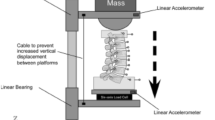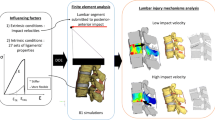Abstract
Spinal burst fractures account for about 15% of spinal injuries and, because of their predominance in the younger population, there are large associated social and healthcare costs. Although several experimental studies have investigated the burst fracture process, little work has been undertaken using computational methods. The aim of this study was to develop a finite element model of the fracture process and, in combination with experimental data, gain a better understanding of the fracture event and mechanism of injury. Experimental tests were undertaken to simulate the burst fracture process in a bovine spine model. After impact, each specimen was dissected and the severity of fracture assessed. Two of the specimens tested at the highest impact rate were also dynamically filmed during the impact. A finite element model, based on CT data of an experimental specimen, was constructed and appropriate high strain rate material properties assigned to each component. Dynamic validation was undertaken by comparison with high-speed video data of an experimental impact. The model was used to determine the mechanism of fracture and the postfracture impact of the bony fragment onto the spinal cord. The dissection of the experimental specimens showed burst fractures of increasing severity with increasing impact energy. The finite element model demonstrated that a high tensile strain region was generated in the posterior of the vertebral body due to the interaction of the articular processes. The region of highest strain corresponded well with the experimental specimens. A second simulation was used to analyse the fragment projection into the spinal canal following fracture. The results showed that the posterior longitudinal ligament became stretched and at higher energies the spinal cord and the dura mater were compressed by the fragment. These structures deformed to a maximum level before forcing the fragment back towards the vertebral body. The final position of the fragment did not therefore represent the maximum dynamic canal occlusion.





Similar content being viewed by others
References
Bilston LE, Thibault LE (1996) The mechanical properties of the human cervical spinal cord in vitro. Ann Biomed Eng 24:67–74
Boerger TO, Limb D, Dickson RA (2000) Does ‘canal clearance’ affect neurological outcome after thoracolumbar burst fractures? J Bone Joint Surg 82B:629–635
Bozic KJ, Keyak JH, Skinner HB, Bueff HU, Bradford DS (1994) Three-dimensional finite element modeling of a cervical vertebra: an investigation of the burst fracture mechanism. J Spinal Disord 7:102–110
Cezayirlioglu H, Bahniuk E, Davy DT, Heiple KG (1985) Anisotropic yield behavior of bone under combined axial force and torque. J Biomech 18:61–69
Chang DG, Tencer AF, Ching RP, Treece B, Senft D, Anderson PA (1994) Geometric changes in the cervical spinal canal during impact. Spine 19:973–980
Chazal J, Tanguy A, Bourges M, Gaurel G, Escande G, Guillot M, Vanneuville G (1985) Biomechanical properties of spinal ligaments and a histological study of the supraspinal ligament in traction. J Biomech 18:167–176
Clohisy JC, Akbarnia BA, Bucholz RD, Burkus JK, Backer RJ (1992) Neurologic recovery associated with anterior decompression of spine fractures at the thoracolumbar junction (T12–L1). Spine 17:S325–S330
Denis F (1983) The three column spine and its significance in the classification of acute thoracolumbar spinal injuries. Spine 8:817–831
Department of Health (2002) Hospital episode statistics England: financial year 2001–2002
Holdsworth FW (1963) Fractures, dislocations and fracture-dislocations of the spine. J Bone Joint Surg 45B:6–20
Lindahl D (1975). Mechanical properties of dried defatted spongy bone. Acta Orthop Scand 47:11–19
Linde F, Norgaard P, Hvid I, Odgaard A, Soballe K (1991) Mechanical properties of trabecular bone. Dependency on strain rate. J Biomech 24:803–809
Martin RB, Boardman DL (1993) The effects of collagen fiber orientation, porosity, density and mineralization on bovine cortical bone bending properties. J Biomech 26:1047–1054
Panagiotacopulos ND, Pope MH, Bloch R, Krag MH (1987) Water content in human intervertebral discs. II. Viscoelastic behavior. Spine 12:918–924
Panjabi MM, Kifune M, Wen L, Arand M, Oxland TR, Lin RM, Yoon WSS, Vasavada A (1995) Dynamic canal encroachment during thoracolumbar burst fractures. J Spinal Disord 8:39–48
Race A, Broom ND, Robertson P (2000) Effect of loading rate and hydration on the mechanical properties of the disc. Spine 25:662–669
Roaf R (1960) A study of the mechanics of spinal injuries. J Bone Joint Surg 42B:810–823
Shirado O (1993) Thoracolumbar burst fractures: an experimental study on cadaveric spines and finite element method. JNippon Seikeigeka Gakkai Zasshi 67:664–654
Silva MJ, Keaveny TM, Wilson CH (1998) Computed tomography-based finite element analysis predicts failure loads and fracture patterns for vertebral sections. J Orthop Res 16:300–308
Spilker R, Jakobs DM, Schultz AB (1986) Material constants for a finite element model of the intervertebral disc with a fiber composite annulus. J Biomech Eng 108:1–11
Tkaczuk H (1968) Tensile properties of human lumbar longitudinal ligaments. Acta Orthop Scand Suppl 115:1–69
Tran NT, Watson NA, Tencer AF, Ching RP, Anderson PA (1995) Mechanism of the burst fracture in the thoracolumbar spine: the effect of loading rate. Spine 20:1984–1988
Whyne CM, Hu SS, Lotz JC (2003). Burst fracture in the metastatically involved spine: development, validation and parametric analysis of a three-dimensional poroelastic finite-element model. Spine 28:652–660
Wilcox RK, Boerger TO, Hall RM, Barton DC, Limb D, Dickson RA (2002) Measurement of canal occlusion during the thoracolumbar burst fracture process. J Biomech 35:381–384
Wilcox RK, Bilston LE, Barton DC, Hall RM (2003) A mathematical model for the viscoelastic properties of dura mater. J Orthop Sci 8:432–434
Wilke H-J, Krischak S, Claes L (1996) Biomechanical comparison of calf and human spines. J Orthop Res 14:500–503
Yamada H, Evans FG (1970) Strength of biological materials. Williams and Wilkins, Baltimore
Author information
Authors and Affiliations
Corresponding author
Rights and permissions
About this article
Cite this article
Wilcox, R.K., Allen, D.J., Hall, R.M. et al. A dynamic investigation of the burst fracture process using a combined experimental and finite element approach. Eur Spine J 13, 481–488 (2004). https://doi.org/10.1007/s00586-003-0625-9
Received:
Revised:
Accepted:
Published:
Issue Date:
DOI: https://doi.org/10.1007/s00586-003-0625-9




